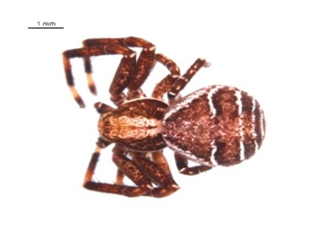(August 26, 2015 North Dumfries/Cambridge): How many different plants and animals live in your backyard? The answer may surprise you. With 2,268 species (as of May, 2015) already known to the rare Charitable Research Reserve – a 900+ acre land trust located at the confluence of the Grand and Speed Rivers in Cambridge – staff, volunteers and researchers from all over the world set out to find even more. They undertook a property-wide inventory, or bioblitz, on Sunday August 16th to see what additional species they could uncover.
In partnership with the Biodiversity Institute of Ontario (BIO) and the 6th International Barcode of Life Conference hosted at the University of Guelph, over 100 participants from more than 31 institutions and 17 countries, Argentina, China, Finland, and Namibia to name a few, searched rare for all forms of life including birds, bats, spiders, insects, fish, plants, and mushrooms, counting and identifying what was found. Over 1100 species were discovered on the reserve for the first time, including 775 insects, 181 spiders, and even one mammal, a Hoary Bat, never before observed. While more charismatic species like birds and butterflies have been well documented at rare through monitoring and citizen sightings, this bioblitz shows the magnitude of species existing in front of our eyes and under our feet that we easily miss. Three of the nearly 200 spiders found are new records for the province, including this crab spider, Xysticus winnipegensis.
Crab spider (Xysticus winnipegensis) discovered in Ontario for the first time at the rare Charitable Research Reserve
Individual specimens collected, with the exception of birds and mammals, were identified with the help of a procedure called DNA barcoding. Founded by Dr. Paul Hebert at the University of Guelph, this method uses a small piece of tissue from the organism, isolates a specific genetic marker, and then reads its DNA sequence. The sequence is matched to a growing database of DNA barcodes that has recently surpassed 500,000 species. The process works much like reading a product barcode at the checkout of a supermarket.
“For most life inhabiting our planet, identifying an organism to species using traditional techniques is incredibly difficult” says Jeremy deWaard, Director of Collections at BIO. “There are many professionals and naturalists that can identify the 400 well-documented species of Canadian birds. But there is no single person in Canada who can identify all of the country’s 3,400 species of mushrooms, or someone for the 5,800 green plants or the 5,400 moths and butterflies. Too little is known about these groups still and the resources to help identify them, like field guides, are incomplete. So if you want to survey the organisms that inhabit an area, and to do it rapidly and comprehensively, you need to employ an innovative tool like DNA barcoding. We did just that at the bioblitz and the results were astounding.”
The bioblitz spanned nearly 12 hours, covered a variety of different habitats found at rare, and included a barbeque dinner for all participants, but it did not stop there. In the week that followed, over 100 collaborators drafted and published a data release manuscript in Biodiversity Data Journal that summarized the findings on the reserve and highlighted the advantages of a rapid blitz approach to species surveys like this one.
Information on the diversity of species living on the reserve is invaluable to their continued efforts to protect the land. “Not only learning about what lives here at rare, but also having knowledge of specific locations allows us to make more informed management decisions and attract new exciting research to the region,” says Jenna Quinn, Program Scientist at rare, adding that there are plans to make this an annual event, “having such success just makes we wonder what else is here that we haven’t found yet!”
About rare
The rare reserve is an urban land trust protecting more than 900 acres of forested land, wetlands, meadows and farmland. The property runs adjacent to the Grand River between Fountain St. and the Galt area of Cambridge. The charity is committed to conserving the land as well as education, research, and community engagement. Their Chain of Learning principle makes it possible for young children to benefit by research done by senior scientists.
A Natural Investment, the organization’s current capital campaign of $17 million, will preserve and restore the land, renovate the historic buildings and offer programs to the public. To date, the charity has raised $13 million.
For more information on the latest news check us out online: www.raresites.org and on Facebook and Twitter @raresites.
About The Biodiversity Institute of Ontario (BIO) Biodiversity measures the variation of life shaped through ecology and evolution from genes to species and ecosystems. The Biodiversity Institute of Ontario at the University of Guelph is a research centre dedicated to the study of biodiversity at multiple levels of biological organization, with particular emphasis placed upon the study of biodiversity at the species level. BIO is the birthplace of the field of DNA barcoding, whereby short, standardized gene sequences are used to accelerate species discovery and identification.
BIO coordinates the International Barcode of Life Project, the largest research program ever undertaken in biodiversity genomics. BIO plays a special role in leading Canadian contributions to this initiative, with emphasis on the development of efficient collection and preservation methods, high-throughput laboratory protocols, and the Barcode of Life Data (BOLD) Systems – an online workbench and database for the global barcoding community.
For more info on BIO, please visit us at www.biodiversity.ca and on Facebook and Twitter @BIO_Outreach
Contacts:
rare Research Department
519-650-9336
research@raresites.org


Comments are closed.